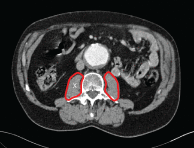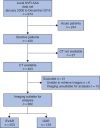Influence of psoas muscle area on mortality following elective abdominal aortic aneurysm repair
- PMID: 30706453
- PMCID: PMC7938852
- DOI: 10.1002/bjs.11074
Influence of psoas muscle area on mortality following elective abdominal aortic aneurysm repair
Abstract
Background: The effect of sarcopenia based on the total psoas muscle area (TPMA) on CT is inconclusive in patients undergoing abdominal aortic aneurysm (AAA) intervention. The aim of this prospective cohort study was to evaluate morphometric sarcopenia as a method of risk stratification in patients undergoing elective AAA intervention.
Methods: TPMA was measured on preintervention CT images of patients undergoing elective endovascular aneurysm repair (EVAR) or open aneurysm repair. Mortality was assessed in relation to preintervention TPMA using Cox regression analysis, with calculation of hazard ratios at 30 days, 1 year and 4 years. Postintervention morbidity was evaluated in terms of postintervention care, duration of hospital stay and 30-day readmission. Changes in TPMA on surveillance EVAR imaging were also evaluated.
Results: In total, 382 patient images acquired between March 2008 and December 2016 were analysed. There were no significant intraobserver and interobserver differences in measurements of TPMA. Preintervention TPMA failed to predict morbidity and mortality at all time points. The mean(s.d.) interval between preintervention and surveillance imaging was 361·3(111·2) days. A significant reduction in TPMA was observed in men on surveillance imaging after EVAR (mean reduction 0·63(1·43) cm2 per m2 ; P < 0·001). However, this was not associated with mortality (adjusted hazard ratio 1·00, 95 per cent c.i. 0·99 to 1·01; P = 0·935).
Conclusion: TPMA is not a suitable risk stratification tool for patients undergoing effective intervention for AAA.
© 2019 BJS Society Ltd. Published by John Wiley & Sons Ltd.
Figures






Comment in
-
Correspondence.Br J Surg. 2019 Jun;106(7):951-952. doi: 10.1002/bjs.11211. Br J Surg. 2019. PMID: 31162651 No abstract available.
-
Correspondence.Br J Surg. 2019 Jun;106(7):951. doi: 10.1002/bjs.11212. Br J Surg. 2019. PMID: 31162665 No abstract available.
References
-
- Powell JT, Sweeting MJ, Ulug P, Blankensteijn JD, Lederle FA, Becquemin JPet al. .; EVAR-1, DREAM, OVER and ACE Trialists. Meta-analysis of individual-patient data from EVAR-1, DREAM, OVER and ACE trials comparing outcomes of endovascular or open repair for abdominal aortic aneurysm over 5 years. Br J Surg 2017; 104: 166–178. - PMC - PubMed
-
- EVAR trial participants . Endovascular aneurysm repair and outcome in patients unfit for open repair of abdominal aortic aneurysm (EVAR trial 2): randomised controlled trial. Lancet 2005; 365: 2187–2192. - PubMed
-
- Patel R, Sweeting MJ, Powell JT. Endovascular versus open repair of abdominal aortic aneurysm in 15-years' follow-up of the UK endovascular aneurysm repair trial 1 (EVAR trial 1): a randomised controlled trial. J Vasc Surg 2017; 65: 585. - PubMed
-
- Grant SW, Hickey GL, Wisely NA, Carlson ED, Hartley RA, Pichel ACet al. . Cardiopulmonary exercise testing and survival after elective abdominal aortic aneurysm repair. Br J Anaesth 2015; 114: 430–436. - PubMed
-
- Waton S, Katriina H, Cromwell D, Loftus I, Boyle J. National Vascular Registry: 2017 Annual Report (Version 2). Royal College of Surgeons of England: London, 2018.

